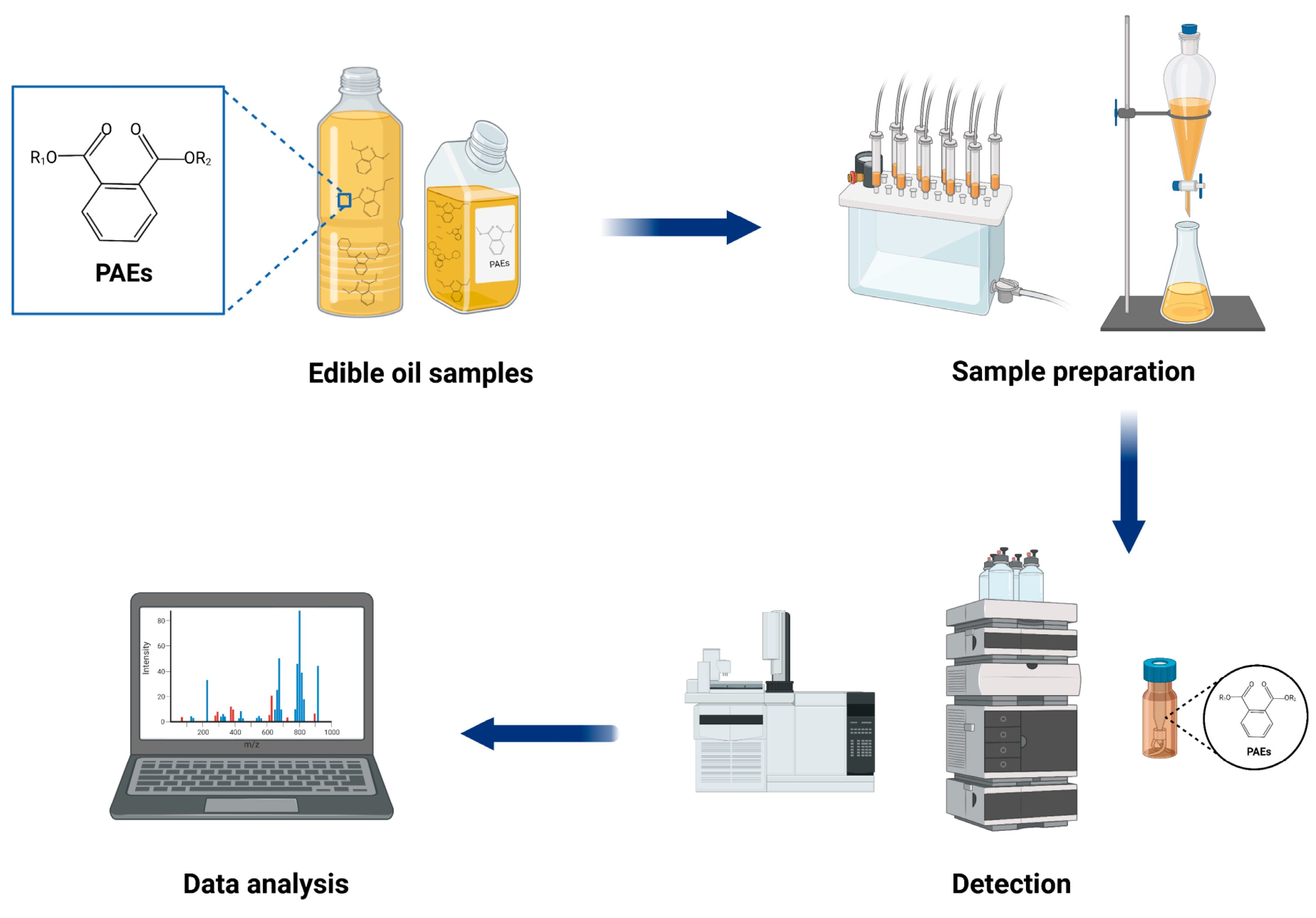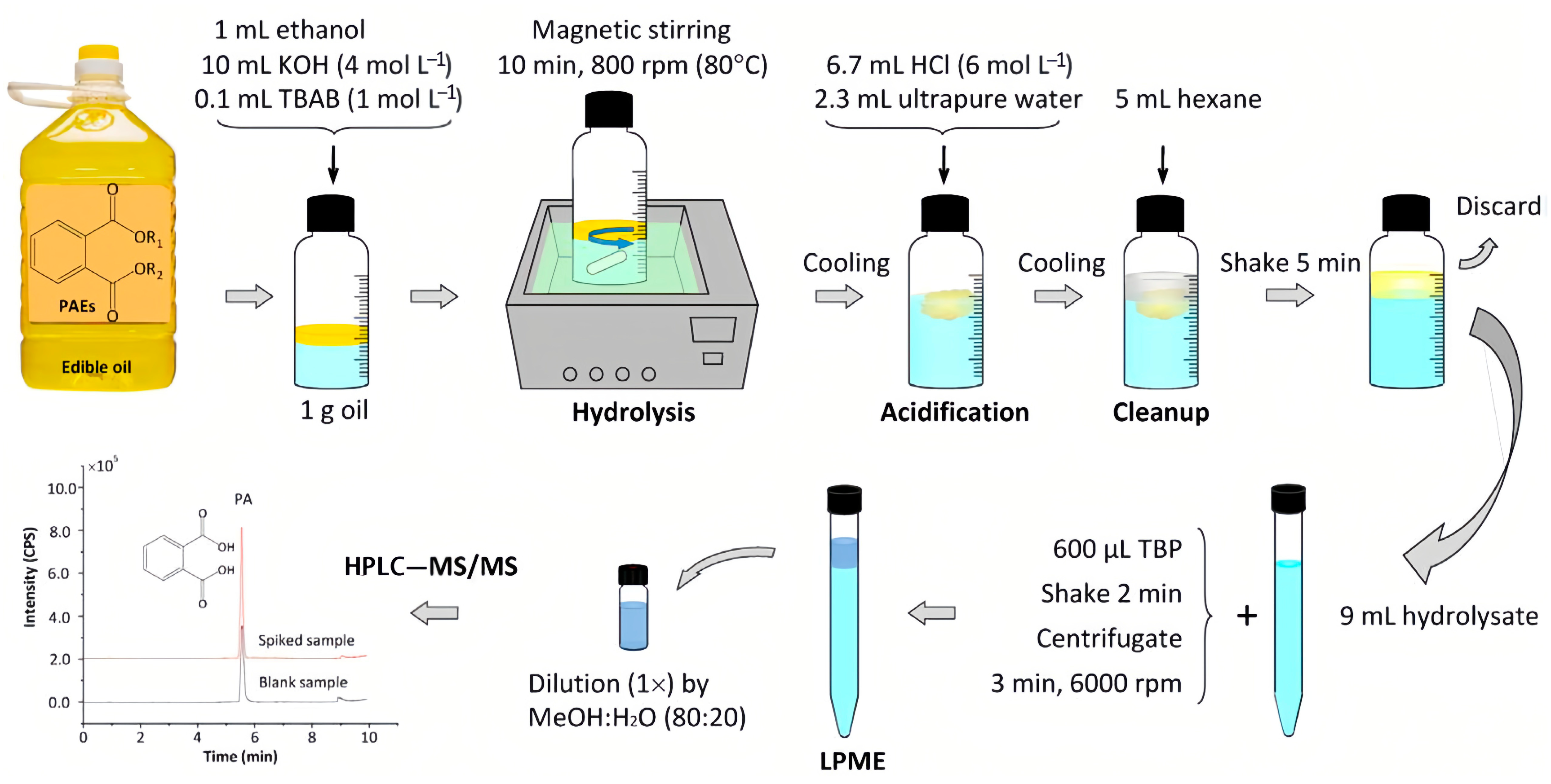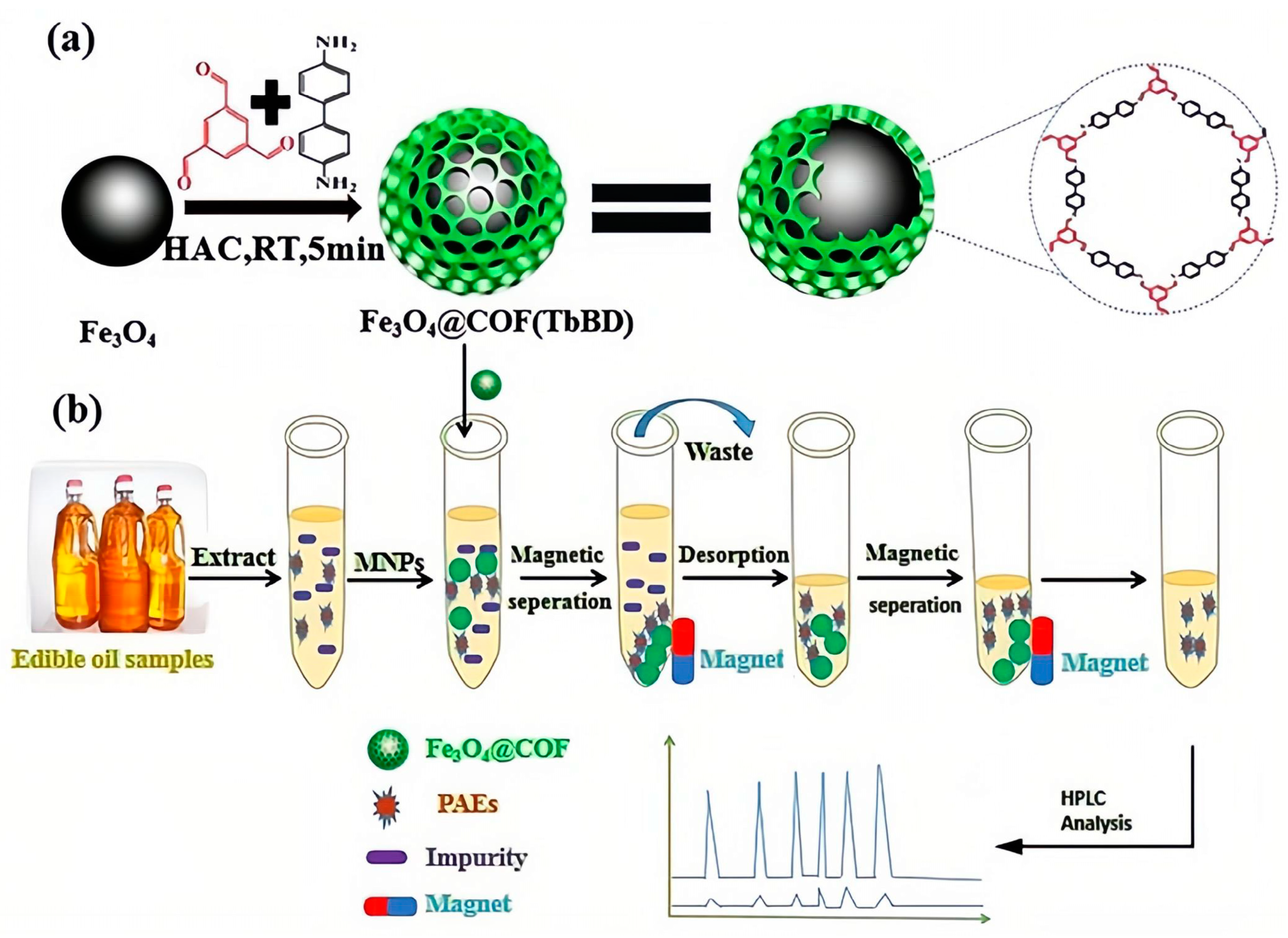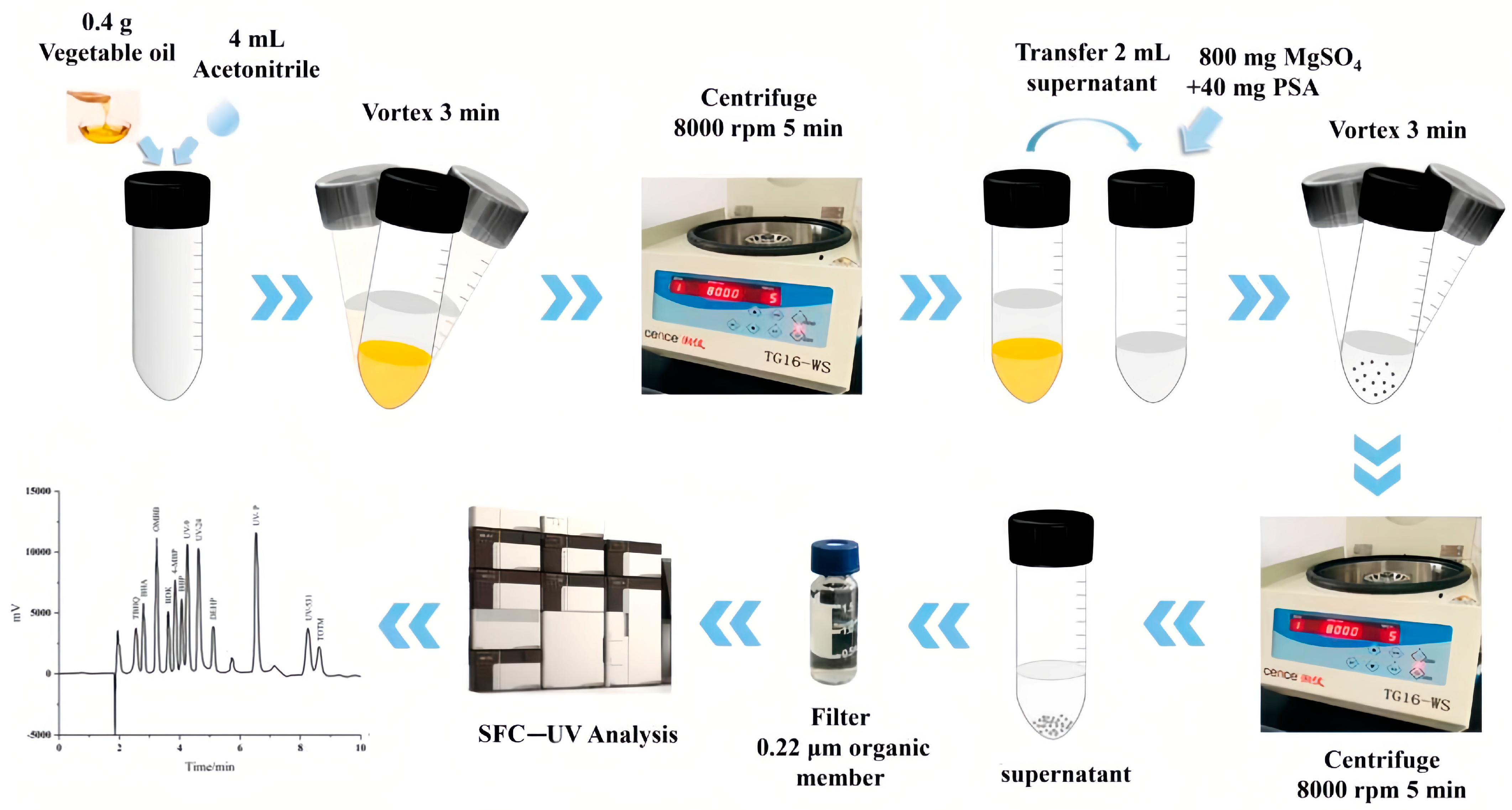Current Sample Preparation Methods and Determination Techniques for the Determination of Phthalic Acid Ester Plasticizers in Edible Oils
Abstract
1. Introduction
2. Sample Preparation Methods
2.1. Liquid-Based Extraction Techniques
2.2. Gel Permeation Chromatography
2.3. Sorptive-Based Extraction Techniques
2.4. QuEChERS
3. Detection Techniques
3.1. Gas Chromatography
3.2. Liquid Chromatography
3.3. Immunoassay
3.4. Other Technologies
4. Conclusions
Author Contributions
Funding
Institutional Review Board Statement
Informed Consent Statement
Data Availability Statement
Conflicts of Interest
Sample Availability
References
- Chang, W.H.; Herianto, S.; Lee, C.C.; Hung, H.; Chen, H.-L. The effects of phthalate ester exposure on human health: A review. Sci. Total Environ. 2021, 786, 147371. [Google Scholar] [CrossRef] [PubMed]
- Harunarashid, N.Z.I.H.; Lim, L.H.; Harunsani, M.H. Phthalate Sample Preparation Methods and Analysis in Food and Food Packaging: A Review. Food Anal. Methods 2017, 10, 3790–3814. [Google Scholar] [CrossRef]
- Mirzajani, R.; Kardani, F.; Ramezani, Z. Fabrication of UMCM-1 based monolithic and hollow fiber—Metal-organic framework deep eutectic solvents/molecularly imprinted polymers and their use in solid phase microextraction of phthalate esters in yogurt, water and edible oil by GC-FID. Food Chem. 2020, 314, 126179. [Google Scholar] [CrossRef] [PubMed]
- Zhao, Y.; Zhu, Z.; Liu, J.; Liu, J.; Li, G. Magnetic Solid-Phase Extraction Followed by HPLC–DAD for Highly Sensitive Determination of Phthalate Esters in Edible Vegetable Oils. Food Anal. Methods 2021, 14, 2375–2385. [Google Scholar] [CrossRef]
- Luo, Q.; Liu, Z.-h.; Yin, H.; Dang, Z.; Wu, P.-x.; Zhu, N.-w.; Lin, Z.; Liu, Y. Global review of phthalates in edible oil: An emerging and nonnegligible exposure source to human. Sci. Total Environ. 2020, 704, 135369. [Google Scholar] [CrossRef] [PubMed]
- Cheon, Y.-P. Di-(2-ethylhexyl) Phthalate (DEHP) and Uterine Histological Characteristics. Dev. Reprod. 2020, 24, 1–17. [Google Scholar] [CrossRef]
- Kay, V.R.; Bloom, M.S.; Foster, W.G. Reproductive and developmental effects of phthalate diesters in males. Crit. Rev. Toxicol. 2014, 44, 467–498. [Google Scholar] [CrossRef]
- Radke, E.G.; Braun, J.M.; Nachman, R.M.; Cooper, G.S. Phthalate exposure and neurodevelopment: A systematic review and meta-analysis of human epidemiological evidence. Environ. Int. 2020, 137, 105408. [Google Scholar] [CrossRef]
- Kay, V.R.; Chambers, C.; Foster, W.G. Reproductive and developmental effects of phthalate diesters in females. Crit. Rev. Toxicol. 2013, 43, 200–219. [Google Scholar] [CrossRef]
- Muscogiuri, G.; Colao, A. Phtalates: New cardiovascular health disruptors? Arch. Toxicol. 2017, 91, 1513–1517. [Google Scholar] [CrossRef]
- Rowdhwal, S.S.S.; Chen, J. Toxic Effects of Di-2-ethylhexyl Phthalate: An Overview. BioMed Res. Int. 2018, 2018, 1750368. [Google Scholar] [CrossRef] [PubMed]
- Chen, J.; Zhou, X.; Zhang, H.; Liu, Y.; Cao, C.; Dong, R.; Yuan, Y.; Wang, M.; Lu, Y.; Wu, M.; et al. Association between urinary concentration of phthalate metabolites and impaired renal function in Shanghai adults. Environ. Pollut. 2019, 245, 149–162. [Google Scholar] [CrossRef] [PubMed]
- Giuliani, A.; Zuccarini, M.; Cichelli, A.; Khan, H.; Reale, M. Critical Review on the Presence of Phthalates in Food and Evidence of Their Biological Impact. Int. J. Environ. Res. Public Health 2020, 17, 5655. [Google Scholar] [CrossRef] [PubMed]
- Chiang, C.; Lewis, L.R.; Borkowski, G.; Flaws, J.A. Exposure to di(2-ethylhexyl) phthalate and diisononyl phthalate during adulthood disrupts hormones and ovarian folliculogenesis throughout the prime reproductive life of the mouse. Toxicol. Appl. Pharmacol. 2020, 393, 114952. [Google Scholar] [CrossRef]
- Mughees, M.; Chugh, H.; Wajid, S. Mechanism of phthalate esters in the progression and development of breast cancer. Drug Chem. Toxicol. 2022, 45, 1021–1025. [Google Scholar] [CrossRef]
- Zhang, M.; Bu, X.; Xu, X.; Wang, B.; Yang, S.; Luo, Y.; Xu, X.; Chen, D. Miniaturized kapok fiber-supported liquid extraction for convenient extraction of pesticide residues in vegetable oils: Determination of organochlorine pesticides as a proof-of-concept study. Talanta 2023, 253, 123982. [Google Scholar] [CrossRef]
- Wang, H.; Liu, X.; Tu, M.; Xu, X.; Yang, S.; Chen, D. Current sample preparation methods and analytical techniques for the determination of synthetic antioxidants in edible oils. J. Sep. Sci. 2022, 45, 3874–3886. [Google Scholar] [CrossRef]
- Wang, B.; Xu, X.L.; Zhang, M.Y.; Bu, X.M.; Wang, H.L.; Shi, X.Z.; Xu, X.; Chen, D. A fully green sample preparation method for synthetic antioxidants determination in edible oils based on natural feather fiber-supported liquid extraction. J. Chromatogr. A 2023, 1698, 464004. [Google Scholar] [CrossRef]
- Amelio, M.; Gandalinia, M. Proposal for a fast method to determine routinely 15 plasticisers in olive oil by liquid extraction and Ultra High-Performance Liquid Chromatography Heated Electro Spray Ionisation High Resolution Mass Spectrometry (Orbitrap) analysis. Riv. Ital. Sostanze Grasse 2021, 98, 169–175. [Google Scholar]
- Pardo-Mates, N.; Serrano, F.; Núñez, O. Determination of phthalic acid esters in drinking water and olive oil by ultra-high performance liquid chromatography-electrospray-tandem mass spectrometry: Study of phthalate migration from plastic bottles to drinking water at different domestic exposure conditions. Trends Chromatogr. 2017, 11, 27–48. [Google Scholar]
- Sun, R.; Zhuang, H. An ultrasensitive gold nanoparticles improved real-time immuno-PCR assay for detecting diethyl phthalate in foodstuff samples. Anal. Biochem. 2015, 480, 49–57. [Google Scholar] [CrossRef]
- Zhou, R.-Z.; Jiang, J.; Mao, T.; Zhao, Y.-S.; Lu, Y. Multiresidue analysis of environmental pollutants in edible vegetable oils by gas chromatography-tandem mass spectrometry. Food Chem. 2016, 207, 43–50. [Google Scholar] [CrossRef]
- Li, L.; Sun, Q.; Xin, S.; Yu, L.; Jiang, Z. Detection of Phthalate Esters from Plastic Packaging Materials into Edible Oil by Gas Chromatography-Mass. Appl. Mech. Mater. 2013, 395, 355–358. [Google Scholar] [CrossRef]
- Li, X.; Zhang, Q.; Chen, L.; Zhao, J.; Li, H. Determination of 16 phthalate esters in sesame oil by isotope dilution liquid chromatography with tandem mass spectrometry. Anal. Methods 2018, 10, 3197–3206. [Google Scholar] [CrossRef]
- Helle, N.; Baden, M.; Petersen, K. Automated solid phase extraction. Methods Mol. Biol. 2011, 747, 93–129. [Google Scholar]
- Buszewski, B.; Szultka, M. Past, present, and future of solid phase extraction: A review. Crit. Rev. Anal. Chem. 2012, 42, 198–213. [Google Scholar] [CrossRef]
- Żwir-Ferenc, A.; Biziuk, M. Solid Phase Extraction Technique--Trends, Opportunities and Applications. Pol. J. Environ. Stud. 2006, 15, 677–690. [Google Scholar]
- Anastassiades, M.; Lehotay, S.J.; Stajnbaher, D.; Schenck, F.J. Fast and easy multiresidue method employing acetonitrile extraction/partitioning and “dispersive solid-phase extraction” for the determination of pesticide residues in produce. J. AOAC Int. 2003, 86, 412–431. [Google Scholar] [CrossRef]
- Gan, Y.; Zhu, Y. Multi-Residue Analysis of Chemical Additives in Edible Vegetable Oils Using QuEChERS Extraction Method Followed by Supercritical Fluid Chromatography. Molecules 2022, 27, 1681. [Google Scholar] [CrossRef] [PubMed]
- Wang, X.; Sun, X.; Wang, X.; Qi, X.; Wang, D.; Jiang, J.; Mao, J.; Ma, F.; Yu, L.; Zhang, L.; et al. Determination of 15 phthalic acid esters based on GC-MS/MS coupled with modified QuEChERS in edible oils. Food Chem. X 2022, 16, 100520. [Google Scholar] [CrossRef]
- Liu, S.; Liu, L.; Han, Y.; Sun, J.; Feng, J.; Wang, J.; Zhong, C. Rapid screening of edible oils for phthalates using phase-transfer catalyst-assisted hydrolysis and liquid phase microextraction coupled to high performance liquid chromatography-tandem mass spectrometry. J. Chromatogr. A 2015, 1420, 26–34. [Google Scholar] [CrossRef] [PubMed]
- Farajzadeh, M.A.; Mogaddam, M.R.A.; Feriduni, B.; Alizadeh, A.A. Determination of migrated phthalic acid residues into edible oils using a green mode of air-assisted liquid–liquid microextraction followed by high-performance liquid chromatography–diode array detector. J. Iran. Chem. Soc. 2016, 14, 551–559. [Google Scholar] [CrossRef]
- Khoshmaram, L.; Abdolmohammad-Zadeh, H.; Ghaffarzadeh, E. Air-assisted liquid-liquid extraction coupled with dispersive liquid-liquid microextraction and a drying step for extraction and preconcentration of some phthalate esters from edible oils prior to their determination by GC. J. Sep. Sci. 2019, 42, 736–743. [Google Scholar] [CrossRef]
- Pereira, J.A.M.; Casado, N.; Porto-Figueira, P.; Camara, J.S. The Potential of Microextraction Techniques for the Analysis of Bioactive Compounds in Food. Front. Nutr. 2022, 9, 825519. [Google Scholar] [CrossRef] [PubMed]
- Chen, D.; Zhang, M.Y.; Bu, X.M.; Wang, B.; Xu, X.L.; Yang, S.; Sun, Z.; Xu, X. In-syringe cotton fiber-supported liquid extraction coupled with gas chromatography-tandem mass spectrometry for the determination of free 3-mono-chloropropane-1,2-diol in edible oils. J. Chromatogr. A 2022, 1673, 463081. [Google Scholar] [CrossRef] [PubMed]
- Chen, D.; Bu, X.; Xu, X.; Wang, B.; Zhang, M.; Gan, Y.; Yuan, H.; Xia, X. In-pipette-tip kapok fiber-supported liquid extraction/in-situ derivatization coupled with high-performance liquid chromatography for conveniently determining three furfurals. Food Chem. 2023, 415, 135788. [Google Scholar] [CrossRef]
- Rutkowska, M.; Plotka-Wasylka, J.; Sajid, M.; Andruch, V. Liquid-phase microextraction: A review of reviews. Microchem. J. 2019, 149, 103989. [Google Scholar] [CrossRef]
- Liu, H.; Dasgupta, P.K. Analytical chemistry in a drop. Solvent extraction in a microdrop. Anal. Chem. 1996, 68, 1817–1821. [Google Scholar] [CrossRef]
- Mehravar, A.; Feizbakhsh, A.; Sarafi, A.H.M.; Konoz, E.; Faraji, H. Deep eutectic solvent-based headspace single-drop microextraction of polycyclic aromatic hydrocarbons in aqueous samples. J. Chromatogr. A 2020, 1632, 461618. [Google Scholar] [CrossRef]
- Santos, A.P.; Korn, M.G.A.; Lemos, V.A. Methods of liquid phase microextraction for the determination of cadmium in environmental samples. Environ. Monit. Assess. 2017, 189, 444. [Google Scholar] [CrossRef]
- Xie, Q.; Sun, D.; Han, Y.; Jia, L.; Hou, B.; Liu, S.; Li, D. Determination of total phthalates in edible oils by high-performance liquid chromatography coupled with photodiode array detection. J. Sep. Sci. 2016, 39, 857–863. [Google Scholar] [CrossRef] [PubMed]
- Kanu, A.B. Recent developments in sample preparation techniques combined with high-performance liquid chromatography: A critical review. J. Chromatogr. A 2021, 1654, 462444. [Google Scholar] [CrossRef]
- Wang, X.; Chen, C.; Chen, Y.; Kong, F.; Xu, Z. Detection of dibutyl phthalate in food samples by fluorescence ratio immunosensor based on dual-emission carbon quantum dot labelled aptamers. Food Agric. Immunol. 2020, 31, 813–826. [Google Scholar] [CrossRef]
- Han, W.C.; Shi, N.; Wang, X.Y.; Wang, Z.H.; Wang, K.L.; Gao, M.; Yu, L.; Chen, D.; Xu, X. Application of natural cotton fibers as an extraction sorbent for the detection of trans-resveratrol in adulterated peanut oils. Food Chem. 2021, 339, 127885. [Google Scholar] [CrossRef]
- Ötles, S.; Kartal, C. Solid-Phase Extraction (SPE): Principles and Applications in Food Samples. Acta Sci. Pol. Technol. Aliment. 2016, 15, 5–15. [Google Scholar] [CrossRef] [PubMed]
- He, F.; Tian, Y.; Xu, Z.; Luo, L.; Yang, J.; Wang, H.; Sun, Y.; Du, Q.; Shen, Y. Development of an immunochromatographic assay as a screen for detection of total phthalate acid esters in cooking oil. J. Toxicol. Environ. Health Part A 2018, 81, 80–88. [Google Scholar] [CrossRef]
- Wang, X.; Chen, C.; Xu, L.; Zhang, H.; Xu, Z. Development of molecularly imprinted biomimetic immunoassay method based on quantum dot marker for detection of phthalates. Food Agric. Immunol. 2019, 30, 1007–1019. [Google Scholar] [CrossRef]
- Wu, P.; Yang, D.; Zhang, L.; Shen, X.; Pan, X.; Wang, L.; Zhang, J.; Tan, Y.; Feng, L.; Ying, Y. Simultaneous determination of 17 phthalate esters in edible vegetable oils by GC-MS with silica/PSA-mixed solid-phase extraction. J. Sep. Sci. 2012, 35, 2932–2939. [Google Scholar] [CrossRef]
- Li, X.; Xiong, W.; Lin, H.; Zhuo, L.; Lv, S.; Tang, X.; Chen, M.; Zou, Z.; Lin, Z.; Qiu, B.; et al. Analysis of 16 phthalic acid esters in food simulants from plastic food contact materials by LC-ESI-MS/MS. J. Sep. Sci. 2013, 36, 477–484. [Google Scholar] [CrossRef]
- Oh, M.-S.; Lee, S.-H.; Moon, M.H.; Lee, D.S.; Park, H.-M. Simultaneous analysis of phthalates, adipate and polycyclic aromatic hydrocarbons in edible oils using isotope dilution-gas chromatography-mass spectrometry. Food Addit. Contam. B 2014, 7, 168–175. [Google Scholar] [CrossRef]
- Vavrouš, A.; Pavloušková, J.; Ševčík, V.; Vrbík, K.; Čabala, R. Solution for blank and matrix difficulties encountered during phthalate analysis of edible oils by high performance liquid chromatography coupled with tandem mass spectrometry. J. Chromatogr. A 2016, 1456, 196–204. [Google Scholar] [CrossRef]
- Ibrahim, N.; Osman, R.; Abdullah, A.; Saim, N. Determination of Phthalate Plasticisers in Palm Oil Using Online Solid Phase Extraction-Liquid Chromatography (SPE-LC). J. Chem. 2014, 2014, 682975. [Google Scholar] [CrossRef]
- Chen, N.; He, J.; Wu, C.; Li, Y.; Suo, A.; Wei, H.; He, L.; Zhang, S. Synthesis of molecularly imprinted polymers by atom transfer radical polymerization for the solid-phase extraction of phthalate esters in edible oil. J. Sep. Sci. 2017, 40, 1327–1333. [Google Scholar] [CrossRef]
- Zhang, S.; Yang, Q.; Li, Z.; Wang, W.; Zang, X.; Wang, C.; Wang, Z. Solid phase microextraction of phthalic acid esters from vegetable oils using iron (III)-based metal-organic framework/graphene oxide coating. Food Chem. 2018, 263, 258–264. [Google Scholar] [CrossRef]
- Barp, L.; Purcaro, G.; Franchina, F.A.; Zoccali, M.; Sciarrone, D.; Tranchida, P.Q.; Mondello, L. Determination of phthalate esters in vegetable oils using direct immersion solid-phase microextraction and fast gas chromatography coupled with triple quadrupole mass spectrometry. Anal. Chim. Acta 2015, 887, 237–244. [Google Scholar] [CrossRef]
- Rios, J.J.; Morales, A.; Marquez-Ruiz, G. Headspace solid-phase microextraction of oil matrices heated at high temperature and phthalate esters determination by gas chromatography multistage mass spectrometry. Talanta 2010, 80, 2076–2082. [Google Scholar] [CrossRef] [PubMed]
- Amanzadeh, H.; Yamini, Y.; Moradi, M.; Asl, Y.A. Determination of phthalate esters in drinking water and edible vegetable oil samples by headspace solid phase microextraction using graphene/polyvinylchloride nanocomposite coated fiber coupled to gas chromatography-flame ionization detector. J. Chromatogr. A 2016, 1465, 38–46. [Google Scholar] [CrossRef] [PubMed]
- Uansiri, S.; Vichapong, J.; Kanchanamayoon, W. HS-SPME for the Determination of Phthalate Esters in Vegetable Oil and Soft Drink Samples. Chiang Mai J. Sci. 2018, 45, 1052–1061. [Google Scholar]
- Wu, C.; He, J.; Chen, N.; Li, Y.; Yuan, L.; Zhao, D.; He, L.; Gu, K.; Zhang, S. Synthesis of cobalt-based magnetic nanoporous carbon core-shell molecularly imprinted polymers for the solid-phase extraction of phthalate plasticizers in edible oil. Anal. Bioanal. Chem. 2018, 410, 6943–6954. [Google Scholar] [CrossRef]
- Duan, C.; Shen, Z.; Wu, D.; Guan, Y. Recent developments in solid-phase microextraction for on-site sampling and sample preparation. TrAC Trends Anal. Chem. 2011, 30, 1568–1574. [Google Scholar] [CrossRef]
- Kataoka, H. SPME techniques for biomedical analysis. Bioanalysis 2015, 7, 2135–2144. [Google Scholar] [CrossRef] [PubMed]
- Risticevic, S.; Niri, V.H.; Vuckovic, D.; Pawliszyn, J. Recent developments in solid-phase microextraction. Anal. Bioanal. Chem. 2009, 393, 781–795. [Google Scholar] [CrossRef] [PubMed]
- Jiang, G.; Huang, M.; Cai, Y.; Lv, J.; Zhao, Z. Progress of solid-phase microextraction coatings and coating techniques. J. Chromatogr. Sci. 2006, 44, 324–332. [Google Scholar] [CrossRef] [PubMed]
- Jiang, H.; Li, N.; Cui, L.; Wang, X.; Zhao, R. Recent application of magnetic solid phase extraction for food safety analysis. TrAC Trends Anal. Chem. 2019, 120, 115632. [Google Scholar] [CrossRef]
- Sun, L.; Tian, W.; Fang, Y.; Yang, W.; Hu, Q.; Pei, F. Rapid and simultaneous extraction of phthalates, polychlorinated biphenyls and polycyclic aromatic hydrocarbons from edible oil for GC–MS determination. J. Food Compos. Anal. 2022, 114, 104827. [Google Scholar] [CrossRef]
- Xie, Q.; Liu, S.; Fan, Y.; Sun, J.; Zhang, X. Determination of phthalate esters in edible oils by use of QuEChERS coupled with ionic-liquid-based dispersive liquid-liquid microextraction before high-performance liquid chromatography. Anal. Bioanal. Chem. 2014, 406, 4563–4569. [Google Scholar] [CrossRef]
- Shi, L.-K.; Zhang, M.-M.; Liu, Y.-L. Concentration and survey of phthalic acid esters in edible vegetable oils and oilseeds by gas chromatography-mass spectrometry in China. Food Control 2016, 68, 118–123. [Google Scholar] [CrossRef]
- Xing, Y.; Wu, J. Determination of 15 PAEs in Fatty Food by SPE-GC/MS. Appl. Mech. Mater. 2014, 469, 458–463. [Google Scholar] [CrossRef]
- Lu, C.; Tang, Z.; Gao, X.; Ma, X.; Liu, C. Computer-aided design of magnetic dummy molecularly imprinted polymers for solid-phase extraction of ten phthalates from food prior to their determination by GC-MS/MS. Microchim. Acta 2018, 185, 373. [Google Scholar] [CrossRef]
- Cui, X.; Wu, P.; Lai, D.; Zheng, S.; Chen, Y.; Eremin, S.A.; Peng, W.; Zhao, S. Development of a Highly Specific Fluorescence Immunoassay for Detection of Diisobutyl Phthalate in Edible Oil Samples. J. Agric. Food Chem. 2015, 63, 9372–9378. [Google Scholar] [CrossRef]
- Wang, H.; Wang, C.; Huang, J.; Liu, Y.; Wu, Y.; You, R.; Zhang, J.H.; Lu, Y.; Shen, H. Preparation of SERS substrate with 2D silver plate and nano silver sol for plasticizer detection in edible oil. Food Chem. 2023, 409, 135363. [Google Scholar] [CrossRef] [PubMed]




| Name | Abbreviation | CAS Number | Structure | Formula | Molecular Mass (g/mol) | Log P * |
|---|---|---|---|---|---|---|
| dimethyl phthalate | DMP | 131-11-3 |  | C10H10O4 | 194.18 | 1.98 |
| diethyl phthalate | DEP | 84-66-2 |  | C12H14O4 | 222.24 | 2.69 |
| dibutyl phthalate | DBP | 84-74-2 |  | C16H22O4 | 278.34 | 4.63 |
| benzyl butyl phthalate | BBP | 85-68-7 |  | C19H20O4 | 312.36 | 5.03 |
| di(2-ethylhexyl) phthalate | DEHP | 117-81-7 |  | C24H38O4 | 390.56 | 8.03 |
| dicyclohexyl phthalate | DCHP | 84-61-7 |  | C20H26O4 | 330.42 | 5.58 |
| diisononyl phthalate | DINP | 28553-12-0 |  | C26H42O4 | 418.62 | 8.76 |
| Sample Amount | Analytes | Solvent Usage | Sample Preparation | Detection | LODs | Ref. |
|---|---|---|---|---|---|---|
| 0.1 g | 12 PAEs (DMP etc.) | Extraction solvent: 900 µL of n-hexane saturated acetonitrile | LLE | LC-HRMS | 0.02–0.35 mg/kg | [19] |
| 0.5 g | 17 PAEs (DMP etc.) | Extraction solvent: 40 mL of hexane-saturated acetonitrile | LLE | GC-MS/MS | 0.1–4.0 µg/kg | [22] |
| 2 g | 10 PAEs (DMP etc.) | Extraction solvent: 5 mL of acetonitrile | LLE | LC-MS/MS | 1–9 µg/L | [20] |
| 50 g | DEP | Extraction solvent: 75 mL of a mixture of hexane and acetone (1:1, v/v) | LLE | GNP-rt-IPCR | 1.06 pg/L | [21] |
| 1 g | PA (hydrolysate of total PAEs) | Extraction solvent: 600 µL of TBP | LPME | LC-MS/MS | 1.0 µmol/kg | [31] |
| 5 mL | o-PA, m-PA, p-PA | Extraction solvent: 34 µL of ammoniacal buffer | AA-LPME | LC-DAD | 0.11–0.29 ng/mL | [32] |
| 0.5 mL | 5 PAEs (DMP etc.) | For AALLE, extraction solvent: 1 mL of DMSO;For DLLME, dispersive solvent: DMSO (from AALLE); extraction solvent: 0.45 mL of chloroform | AALLE and DLLME | GC-FID/GC-MS | 0.007–0.023 µg/L | [33] |
| Sample Amount | Analytes | Sorbents | Sample Preparation | Detection | LODs | Ref. |
|---|---|---|---|---|---|---|
| 2 g | 3 PAEs (DMP etc.) | C18 | SPE | ICA | 3 μg/mL | [46] |
| 1 mL | DBP | PSA | SPE | Fluorescence ratio immunosensor method | 5.0 μg/L | [43] |
| 50 mL | DBP | ProElut PSA | SPE | MIBIA | 0.011 mg/L | [47] |
| 0.4 g | 17 PAEs (DMP etc.) | Silica/PSA-mixed | SPE | GC-MS | 0.1–0.2 mg/kg | [48] |
| 0.5 g | 16 PAEs (DMP etc.) | Florisil® | SPE | LC-MS/MS | 31.9–390.8 µg/kg | [49] |
| 4 g | 3 PAEs (DBP etc.) | Florisil® | LLE and SPE | ID-GC-MS | 4.6–10.0 µg/kg | [50] |
| 2 mL | 6 PAEs (DEP etc.) | C18-modified silica | LLE and SPE | LC-MS/MS | / | [51] |
| 1 mL | 6 PAEs (DMP etc.) | C16 | Online SPE | LC-DAD | 3 µg/L | [52] |
| 2 g | 10 PAEs (DMP etc.) | MIPs | MISPE | GC-FID | 0.10–0.25 µg/mL | [53] |
| 0.5 g | 7 PAEs (DMP etc.) | MIL-88(Fe)/GO | SPME | GC-FID | 0.5–2.0 ng/g | [54] |
| 0.5 g | 10 PAEs (DMP etc.) | PDMS | DI-SPME and LLE | GC-MS/MS | / | [55] |
| 1 g | 16 PAEs (DMP etc.) | DVB/CAR/PDMS | HS-SPME | GC-MS/MS | 0.02–0.05 mg/kg | [56] |
| 1 g | 3 PAEs (DPP etc.) | G/PVC nanocomposite | HS-SPME | GC-FID | 0.06–0.08 µg/L | [57] |
| 5 mL | 4 PAEs (DMP etc.) | PDMS/DVB | HS-SPME | GC-FID | 2.6–3.3 ng/mL | [58] |
| / | 4 PAEs (DMP etc.) | MOF-DES/MIPs | HFLMP-SPME | GC-FID | 0.008–0.03 µg/L | [3] |
| 1 g | 7 PAEs (BBP etc.) | Fe3O4@COF (TbBD) | MSPE | LC-DAD | 0.55–0.95 µg/kg | [4] |
| 5 mL | 5 PAEs (DMP etc.) | Co-MNPC@MIPs | MMISPE | GC-FID | 0.010–0.025 μg/mL | [59] |
| Sample Amount | Analytes | Sorbents (DSPE) | Sample Preparation | Detection | LODs | Ref. |
|---|---|---|---|---|---|---|
| 2 g | 6 PAEs (DMP etc.) | Z-Sep+ and C18 | QuEChERS | GC-MS | 0.02 mg/kg | [65] |
| 0.5 g | 15 PAEs (DMP etc.) | GCB and PSA | QuEChERS | GC-MS/MS | 0.02–8.00 μg/kg | [30] |
| 0.5 g | 4 PAEs (DEP etc.) | primary secondary amine | QuEChERS and IL-DLLME | LC-DAD | 6–9 ng/g | [66] |
| 0.4 g | BBP; DEHP | PSA | QuEChERS | SFC-UV | BBP: 0.09 µg/mLDEHP: 0.12 µg/mL | [29] |
Disclaimer/Publisher’s Note: The statements, opinions and data contained in all publications are solely those of the individual author(s) and contributor(s) and not of MDPI and/or the editor(s). MDPI and/or the editor(s) disclaim responsibility for any injury to people or property resulting from any ideas, methods, instructions or products referred to in the content. |
© 2023 by the authors. Licensee MDPI, Basel, Switzerland. This article is an open access article distributed under the terms and conditions of the Creative Commons Attribution (CC BY) license (https://creativecommons.org/licenses/by/4.0/).
Share and Cite
Qi, M.; Li, Y.; Zhu, Z.; Du, B.; Chen, D. Current Sample Preparation Methods and Determination Techniques for the Determination of Phthalic Acid Ester Plasticizers in Edible Oils. Molecules 2023, 28, 5106. https://doi.org/10.3390/molecules28135106
Qi M, Li Y, Zhu Z, Du B, Chen D. Current Sample Preparation Methods and Determination Techniques for the Determination of Phthalic Acid Ester Plasticizers in Edible Oils. Molecules. 2023; 28(13):5106. https://doi.org/10.3390/molecules28135106
Chicago/Turabian StyleQi, Menghui, Yanyan Li, Zheng Zhu, Bin Du, and Di Chen. 2023. "Current Sample Preparation Methods and Determination Techniques for the Determination of Phthalic Acid Ester Plasticizers in Edible Oils" Molecules 28, no. 13: 5106. https://doi.org/10.3390/molecules28135106
APA StyleQi, M., Li, Y., Zhu, Z., Du, B., & Chen, D. (2023). Current Sample Preparation Methods and Determination Techniques for the Determination of Phthalic Acid Ester Plasticizers in Edible Oils. Molecules, 28(13), 5106. https://doi.org/10.3390/molecules28135106







